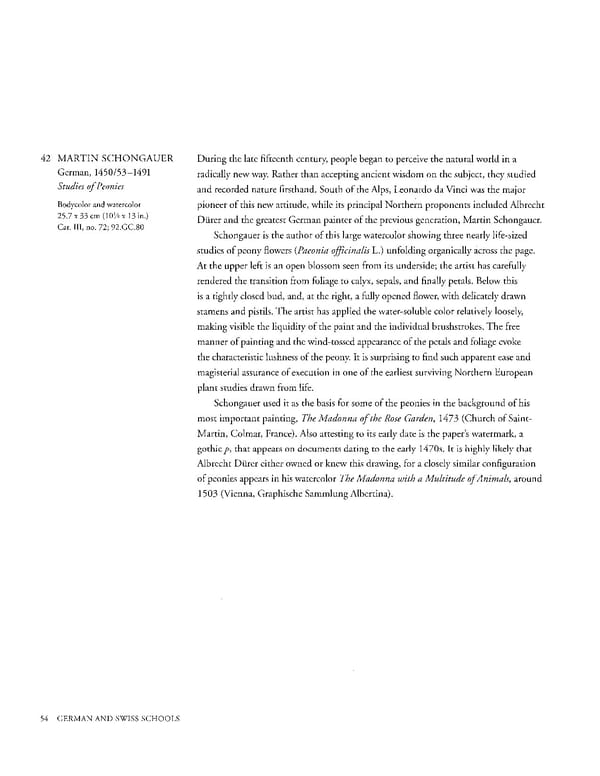42 MARTIN SCHONGAUER During the late fifteenth century, people began to perceive the natural world in a German, 1450/531491 radically new way. Rather than accepting ancient wisdom on the subject, they studied Studies of Peonies and recorded nature firsthand. South of the Alps, Leonardo da Vinci was the major Bodycolor and watercolor pioneer of this new attitude, while its principal Northern proponents included Albrecht 25.7 x 33 cm (10 x 13 in.) Durer and the greatest German painter of the previous generation, Martin Schongauer. Cat. Ill, no. 72; 92.GC.80 Schongauer is the author of this large watercolor showing three nearly lifesized studies of peony flowers (Paeonia officinalis L.) unfolding organically across the page. At the upper left is an open blossom seen from its underside; the artist has carefully rendered the transition from foliage to calyx, sepals, and finally petals. Below this is a tightly closed bud, and, at the right, a fully opened flower, with delicately drawn stamens and pistils. The artist has applied the watersoluble color relatively loosely, making visible the liquidity of the paint and the individual brushstrokes. The free manner of painting and the windtossed appearance of the petals and foliage evoke the characteristic lushness of the peony. It is surprising to find such apparent ease and magisterial assurance of execution in one of the earliest surviving Northern European plant studies drawn from life. Schongauer used it as the basis for some of the peonies in the background of his most important painting, The Madonna of the Rose Garden, 1473 (Church of Saint Martin, Colmar, France). Also attesting to its early date is the paper's watermark, a gothic p, that appears on documents dating to the early 1470s. It is highly likely that Albrecht Durer either owned or knew this drawing, for a closely similar configuration of peonies appears in his watercolor The Madonna with a Multitude of Animals, around 1503 (Vienna, Graphische Sammlung Albertina). 54 GERMAN AND SWISS SCHOOLS
 Masterpieces of the Getty Museum: Drawings Page 54 Page 56
Masterpieces of the Getty Museum: Drawings Page 54 Page 56